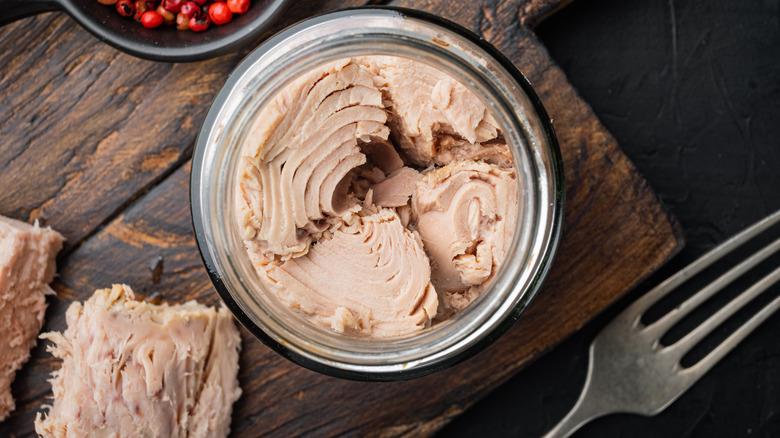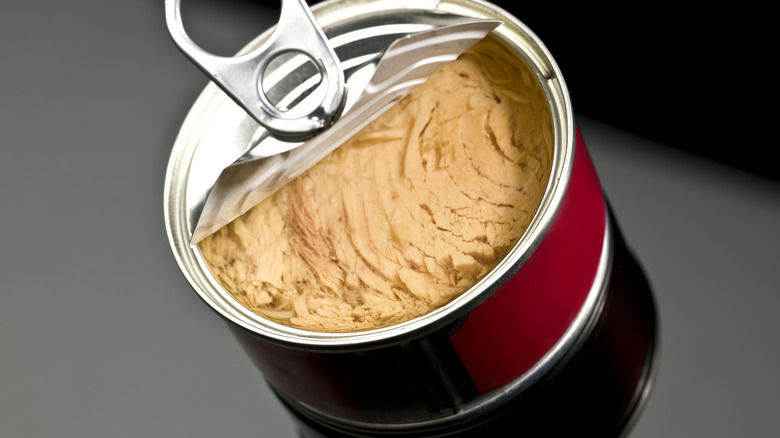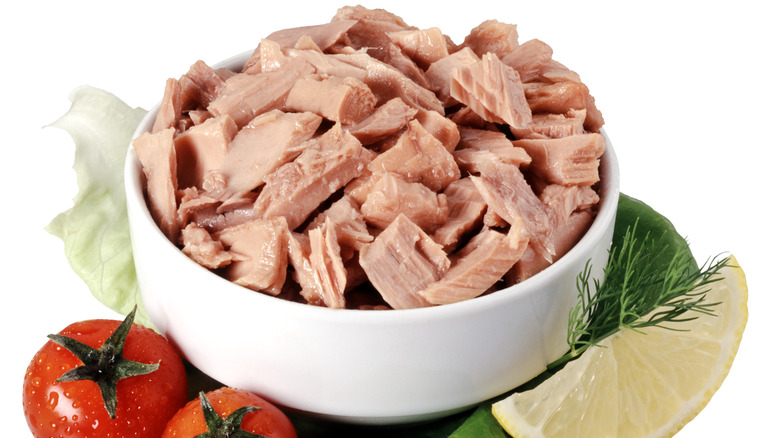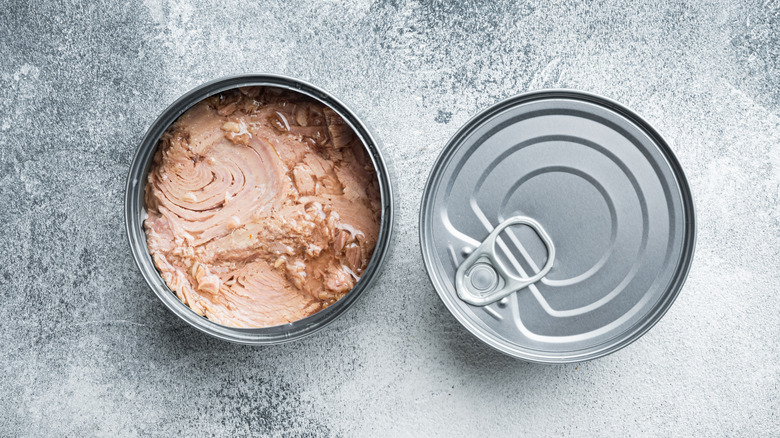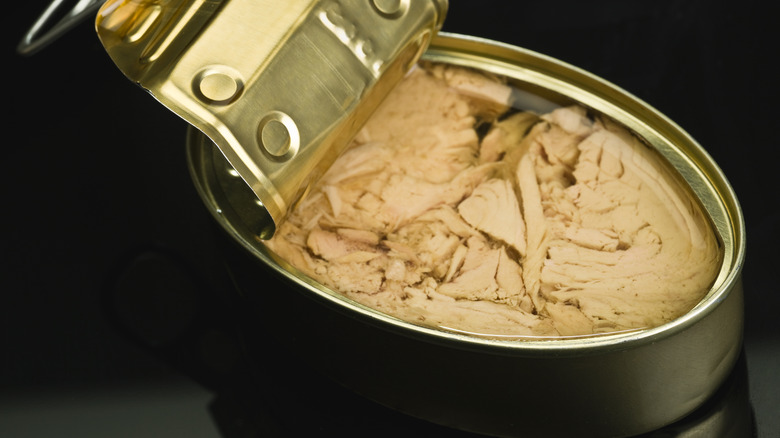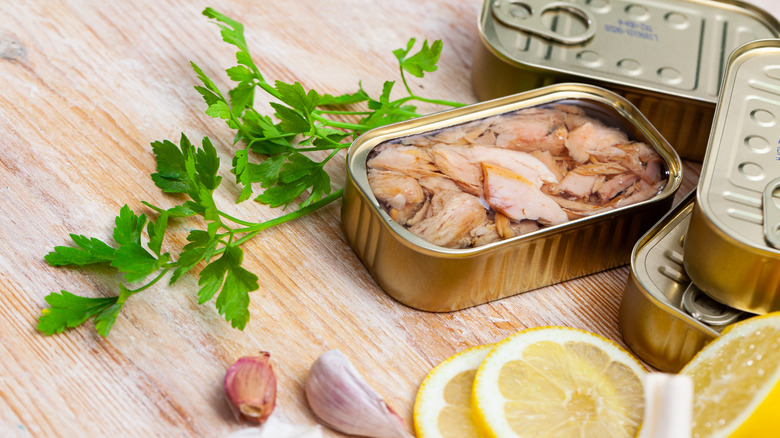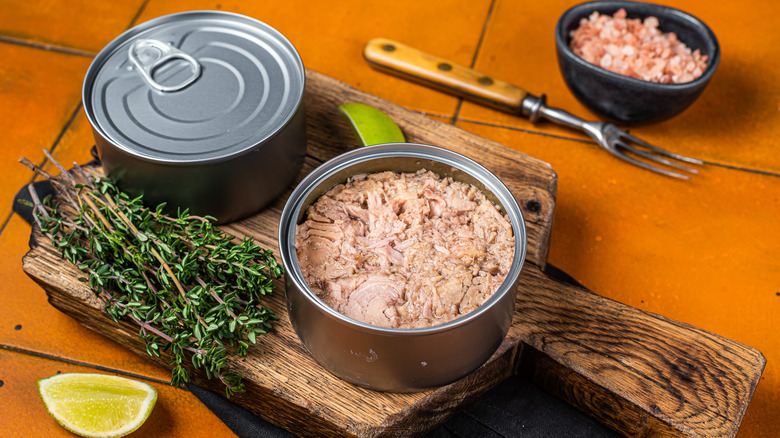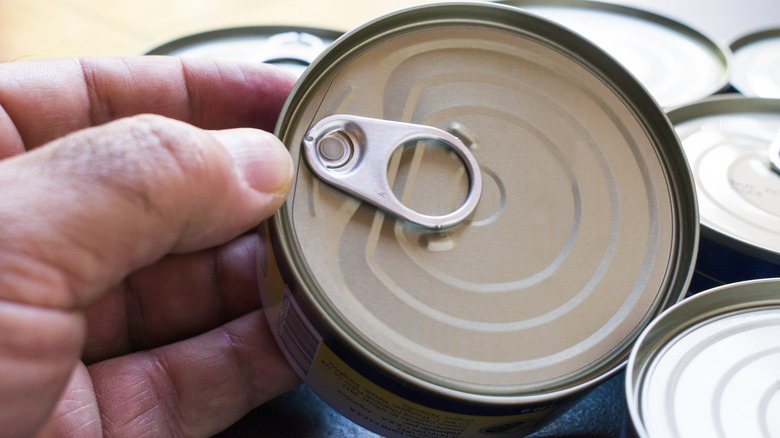9 False Facts About Canned Tuna
Canned tuna is a staple in many pantries, and for good reason. Not only is it cheap and keeps for a while, but it's also a good source of protein that works in a wide variety of recipes. That makes it super convenient, as you'll have a handy backup for protein when your fridge is unexpectedly empty. Simply grab a tin, pop it open, and add it to your favorite salad or pasta — or, you can even eat the tuna straight from the can. Unfortunately, however, it often gets a bad rap due to a lot of misinformation floating around.
There's no need to be hesitant about grabbing a can or two of canned tuna from the grocery store. The information you've heard about it may not be true, as there are many unfounded myths surrounding this tinned fish. This makes it important to separate fact from fiction, so you're clear and confident about what you're eating. Let's take a look at some false facts about canned tuna you should be aware of and what the real deal is.
1. False fact: Canned tuna is high in mercury
Mercury is an element found frequently in nature, including in the water. Since fish live in the water, there are concerns about eating fish, as too much of it can lead to mercury poisoning, which is a type of heavy metal poisoning. These are legitimate worries since mercury is found in the majority of fish, especially larger ones such as tuna.
While there's always a risk of ingesting mercury when you consume seafood, as long as you're conscious about how much fish (and therefore, tuna) you eat, you should be good. In fact, the benefits of eating tuna outweigh the risks, so you shouldn't avoid eating it altogether, and this includes canned tuna. Plus, there's the untrue myth that canned tuna contains more mercury than fresh tuna.
The FDA actually published a list of mercury levels found in fish, including canned and fresh tuna. Surprisingly, the fresh tuna had lower levels of mercury compared to their canned versions, meaning not as much mercury is in your canned tuna. Also, light and skipjack tuna tend to have lower numbers, so if you're trying to minimize your mercury intake, those are the ones to look for.
2. False fact: Canned tuna is low in nutrients
Peel back the lid to any canned food, and you'll see that the contents inside look quite drab. So it's easy to see why the myth that canned tuna has little to no nutrients has prevailed. But you'd be surprised by the truth about the fish inside these tins.
It turns out, the canning process doesn't strip the fish of its nutrients at all. The tuna is only steamed, then combined with salt, water, oil, and/or marinade before sealing. The cans are cooked and sterilized, but this only kills harmful microorganisms — these processes don't compromise the nutrients in the fish.
For example, 1 ounce of canned tuna packed in water has 0.056 g of DHA (a type of omega-3 fatty acid), 0.473 mg of iron, and 5.1 mg of calcium. One ounce of canned tuna packed in oil has 0.029 g of DHA, 0.394 mg of iron, and 3.69 mg of calcium. Compare this to 1 ounce of fresh raw tuna, which has 0.025 g of DHA, 0.218 mg of iron, and 1.13 mg of calcium. What's interesting is that not only does canned tuna retain nutrients after the canning process, but it also increases in some afterward.
3. False fact: Canned tuna is not healthy
There's this consensus that "not fresh" equals "not healthy." This may ring true for some foods, but it certainly doesn't for canned tuna. Remember that the next time you glance in your pantry for something to eat.
Admittedly, fresh tuna has significantly less sodium than its canned counterparts — you'll find 12.8 mg in an ounce, while the numbers are five times higher for tuna packed in water and 10 times higher for tuna packed in oil. This may seem alarming at first, but the FDA recommends that adults receive under 2,300 mg of salt per day, so you'd have to eat a huge amount of canned tuna to hit that number. In addition, when you compare the nutritional values, both types of canned tuna have less cholesterol than fresh tuna does. Canned tuna packed in oil has 2 grams of fat while the other two choices have less than 1 gram, but it's a negligible amount. Otherwise, all three options have a protein content between 5 and 9 grams per ounce, making them great for this essential nutrient.
4. False fact: Canned tuna is full of preservatives
There's a common belief that canned foods are full of preservatives, which is reasonable. After all, these tins seem to last forever, and anything that has a lengthy shelf life surely can't be healthy for you — the brands must use a ton of unnatural chemicals to achieve that. You can rest easy knowing that the FDA carefully examines all additives before authorizing use in products.
But when it comes to canned tuna, this all doesn't matter. It's completely false that these cans are full of preservatives, as there are none, at least not chemically added ones. The canning process means that the tuna's steamed, then salt and water or oil are added, and that's it. You might get additional flavoring with herbs such as basil, but that should be the extent of ingredients you'll find. All of these things, as well as the sealed can, ensure that the meat inside stays edible for a long time.
On that note, does canned tuna ever actually go bad? The short answer is yes, but it takes around five years if you store it properly. This number drops to one year if you're canning the tuna yourself.
5. False fact: Pregnant people can't eat canned tuna
In general, fish is rich in vitamins and minerals, and it's a fantastic source of lean protein. In theory, it's excellent to have in everyone's diet, but since pretty much all fish contain mercury, pregnant people are told not to eat it. This isn't entirely unfounded, as doctors advise them not to eat raw or undercooked fish since there's a higher chance of bacteria and parasites.
You might've noticed that the key words here are "raw or undercooked." The reality is that those who are expecting can still enjoy cooked fish, including canned tuna. Of the possible fish you can eat, the FDA ranks canned light and skipjack tuna as one of the best choices. These actually outrank canned, fresh, and frozen albacore or white tuna, which fall in the "Good Choices" category. As for bigeye tuna, avoid eating it at all since it has the highest mercury levels. According to their list, you can eat two to three servings a week of "Best Choices" fish or one serving a week of "Good Choices" fish if you're pregnant.
6. False fact: Tuna cans contain dangerous amounts of BPA
Bisphenol A (BPA) is a chemical often found in plastics, especially ones that we eat or drink from. There are several health issues linked to BPA, which is why people are very conscious about buying BPA-free products. For instance, of the rice brands to buy and avoid, we generally recommend cooking rice from scratch instead of using "boil-in-the-bag" options — this decreases the chance of BPA leeching into your food.
There's a rumor that canned goods have high amounts of BPA in them. The truth is that yes, it is used to coat the insides of cans, including those that hold tuna. This is to prevent the metal from reacting with the meat, which would then affect the taste. Even those that claim to be BPA-free do have traces of this chemical. However, the good news is that the amount is so minuscule that those eating a moderate amount of canned tuna have nothing to worry about. You need to eat at least 25 cans of tuna to go over the EU guideline maximum of 50 µg/kilograms of bodyweight per day. So unless you plan on excessively gorging yourself on canned tuna daily, then you're safe.
7. False fact: Canned tuna tastes worse than fresh tuna
There's no denying that canned tuna doesn't taste the same as freshly cooked tuna. But the same could be said of raw versus cooked tuna, and there are fans of either (or both!). Taste is a subjective thing, and there's a reason why canned tuna has prevailed — even though it's a cheap product, it's still tasty enough to be a regular part of our diet.
In general, the texture is a little tougher, and the umami flavor is stronger. That's not necessarily bad though! These things make canned tuna outstanding for highlighting other ingredients in recipes, such as casseroles, pasta, tuna salad, and sandwiches. And if you're still not sold on canned tuna, you might not have realized that there are several canned tuna varieties. Grab them from the shelves at your local grocery store and check out what each type has to offer. Chances are, you'll discover a canned tuna that you absolutely love.
8. False fact: Canned tuna isn't a sophisticated food
Canned tuna may give off "broke college student" vibes — many people picture spooning it directly from the can or smushing the meat in between two slices of bread with a sliver of cheese to make a poor excuse of a sandwich. But what a lack of imagination! Canned tuna can definitely be sophisticated, as long as you're willing to flex your creative muscles in the kitchen.
For example, you can craft deliciously crispy croquettes to serve at an upscale brunch with your friends on a lazy Sunday afternoon. Or you can throw together a canned tuna ceviche if you'd like a fancy appetizer for your dinner party with people you want to impress. Basically, you can put a twist on anything you'd make with fresh tuna or even other fish, and you won't have to spend a fortune either. With some culinary prowess, you'll have your guests shocked that your dishes came out of a tin.
9. False fact: Canning tuna isn't sustainable
Sustainability is a huge world topic, especially since we're quickly depleting the planet's resources. We need to take action yesterday, but many of today's practices are challenging to address and change. However, an easier place to start is in the food choices we make, and people have their doubts as to whether canning tuna can be a sustainable practice.
The good news is that canned tuna has a climate footprint of 9.56 kg CO2e/kg, which is much lower when compared to other types of meat. Plus, fisheries are adopting more environmentally friendly fishing methods, such as purse seine fishing. Not only do these methods require fewer boats, but less fuel as well. Another way canning tuna is sustainable is that the waste is repurposed as pet food.
If you want to be extra sure that you're eating sustainable fish, look for cans with the Marine Stewardship Council (MSC) label. This means that the tuna's come from fisheries that have gone through rigorous assessments. The cans are certified sustainable to give you peace of mind.
